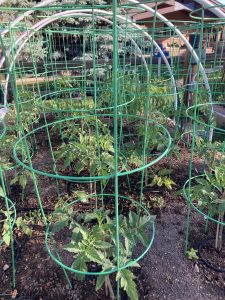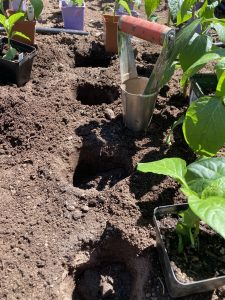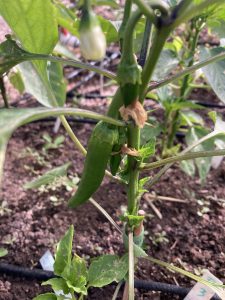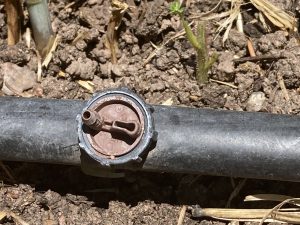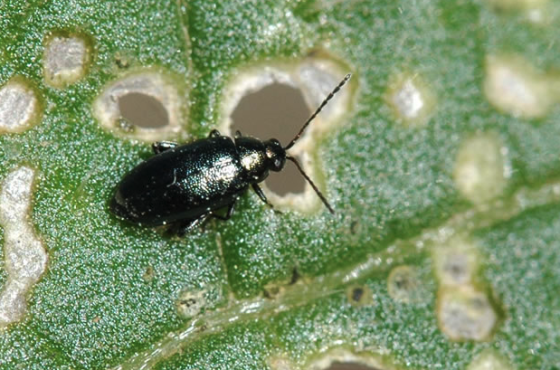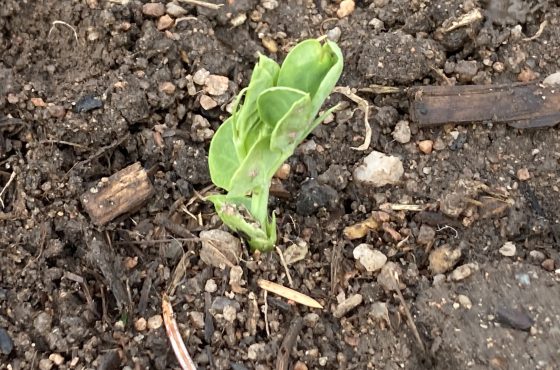PLANTING – WATERING – WEEDING
The season has finally taken off with real summer weather! I have already been harvesting asparagus, spinach, green onions (planted last fall), arugula and lettuce. The snap peas & regular peas are starting to produce fruit with tons of flowers for more to come! The remaining summer veggies will be ready to pick in a month including raspberries, garlic, onions, potatoes, cucumbers, beans.
Planting day for the tomato and pepper seedlings finally arrived on May 26th, a cloudy day which was perfect because the direct hot sun would make them wilt pretty fast. I use 2 of the planter beds for 20 tomato plants each. The spacing is very important since the tomatoes are ‘indeterminant’ which means they will continue to grow up and out and need strong support and space. I space them in a zig zag fashion about 18” apart.
Determinant tomatoes grow ‘bushy’ and are great for containers (I will discuss tomatoes in more detail in a future blog). I use one of the best tools ever for planting – a hole maker which Bill gave to me one Christmas in my stocking! It makes the perfect size hole to slip my starters in!
I use 1 whole planter bed for peppers which will hold the 70 I have and use the same hole maker. I plant them quite a bit closer, about 6” apart since they will get somewhat bushy but not taller than 18” or so. I keep the row cover on the very top so that they don’t get solar burn in the midday sun.
The schedule for watering is set to 2x/day during the middle of summer: early morning just before sunrise and then again mid afternoon when its hottest. You can tell immediately when plants need water – they wilt. Bill is in charge of all the watering. He first set up the tubes around the perimeter of the inside of fence years ago and are still being used. Then each bed has a main tube with a control valve to control the outflow. He makes puncture holes in this central tube and uses either ‘buttons’ or soaker hoses depending on the plant. The whole system is timed on an automated sprinkler timer with 3 zones.
Watering with different tubing has also been trial and error over the years. I had tried the buttons on each tomato plant but this did not sufficiently water them and they did very poorly that year. The soaker hose works best for the rows of plants like tomatoes, potatoes, onions, peppers. The buttons work best on individual plants like zucchini, asparagus and cabbage.
So, since all the vegetables are growing nicely with the heat, the weeds are growing just as fast! I CAN’T STAND all the weeds. They take up so much of my time and I can never get ahead. I have given up on the walkways between the boxes. I tried to prevent weeds using black plastic ground cover over the tomato boxes and made holes in it to put plants in; but even that didn’t work they still came through the microscopic holes! I have never used weed killer on anything in the garden, I just do good old fashioned weeding.
The most prolific weed now is purslane. Luckily, it’s pretty easy to pluck since it has very shallow roots. There are plenty of other weeds like bind weed, crab grass, mallow. After a good rainfall is the best time to weed since the ground is wet. Why is it that grass grows where you don’t want it to? I guess it’s just like hair – grows where you don’t want it!
Listen to this video to hear the humming of bees pollinating my raspberry flowers! Thanks to Sheryl Whipple’s apiary across the street! (be sure to turn up the volume 🙂


